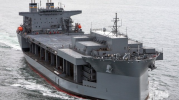Found some accounts and data concerning mines and missiles (nothing on torpedoes). Despite hitting a mine, it was still considered safer for the big tanker to take the lead and the warships to follow in its wake. Perhaps the double hulls, the multiple tanks with plumbing designed to move large amounts of liquids and by design a necessary and effective fire suppression system makes the tankers more difficult to sink than some here have surmised. Certainly the captains of the USS Kidd and the USS Fox which decided to follow in trail seemed to think so.
From the Washington Post concerning the Bridgeton Incident.
https://www.washingtonpost.com/arch...abdf554/?noredirect=on&utm_term=.ff1becd596ef
It was soon clear to officers on the bridge of the supertanker, however, that the damage was minor. "The hit is port {left side} amidships, 100 to 200 feet aft of the bow," said one radio report. "There is no danger to the ship, {there is} plenty of reserve buoyancy here." After the initial damage inspection, the convoy closed ranks to single file, with the Bridgeton in the lead, and the flotilla picked up speed to 10 knots. Murphy, the destroyer captain, told reporters that the mine that hit the Bridgeton was extremely powerful. "If we had hit that, it would have done enormous damage to the Kidd," the captain said. The huge supertanker is more able to absorb such blows.
In a tactic that appeared to put the safety of the Kuwaiti supertanker second to the safety of U.S. warships, the convoy proceeded to Kuwait after the mine went off using the Bridgeton as a plow through the gulf waters in hopes that its massive hull would detonate any additional mines.
Aboard the USS Fox, Capt. William Mathis told reporters that the Kuwaiti supertanker "can take hits easier than we can."
A study from The Strauss Center at the University of Texas had some interesting data on the Tanker War of the late 1980's, comparing tankers to bulk carriers and freighters.
https://www.strausscenter.org/hormuz/tanker-war.html
Lessons Learned
The Tanker War provides a useful historical background on a hypothetical future conflict in the Strait of Hormuz. Below are some key takeaways from the eight-year conflict:
Oil tankers are not very vulnerable to damage. 61 percent of the ships attacked during the Tanker War were oil tankers. In total, only 55 of the 239 petroleum tankers (23 percent) were completely sunk or declared CTL, compared to 39 percent of bulk carriers and 34 percent of freighters.
As for adaptability, the Expeditionary Transfer Dock which are in service and are being built are based on the Alaska class VLCC tanker. The original purpose built design was $1.5 billion per copy, by adapting the existing tanker design, the price was reduced 66% down to $500 million.
ESB variant
USS Lewis B. Puller
It was mentioned earlier that WW2 was won with the Essex class carrier, etc. However one could argue that adapting civilian designs was more cost effective for some missions that did not require an Essex. Only 24 Essex class were built, however 122 escort carriers were built - the Avenger class, the Sangamon class, and the Bogue class escort carriers were all built on merchant hulls. With shipbuilding cost very high and some of the designs over budget, behind schedule or quite disappointing as well as not being built in the numbers planned, perhaps it might be worth a study to see if adapting some civilian hulls for specialized missions might be worthwhile.
Finally, it does seem to be a time of innovation as the Surface Navy discusses distributed lethality
https://usnwc.edu/News-and-Events/News/Distributed-Lethality-concept-gains-focus-at-NWC
and the Marines testing HIMARS from the decks of LPD's.
http://cimsec.org/want-broadside-marines-need-naval-fire-support/31347
Will be interesting to see where it leads...


